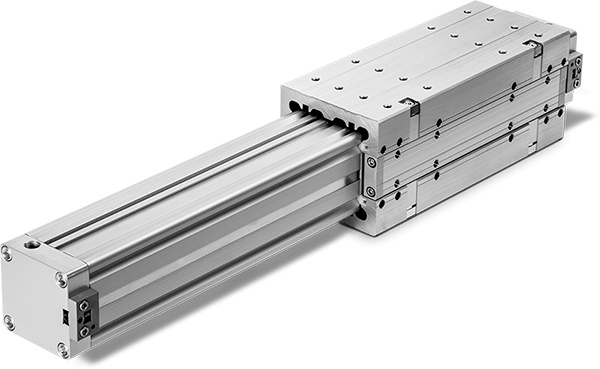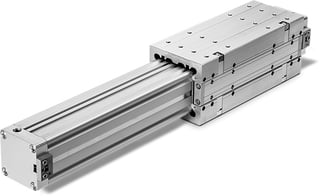
 Pneumatic linear actuators offer numerous advantages across a wide variety of applications. However, they must be spec’d properly. Otherwise, the result could be less-than-desired productivity and greater-than-expected problems, downtime, and costs. There are several factors that affect sizing.
Pneumatic linear actuators offer numerous advantages across a wide variety of applications. However, they must be spec’d properly. Otherwise, the result could be less-than-desired productivity and greater-than-expected problems, downtime, and costs. There are several factors that affect sizing.
Avoiding these five common mistakes will help you choose the best size pneumatic linear actuator for any given application and environment:
Mistake #1: Oversizing
Bigger is not always better. When sizing a pneumatic cylinder for your application it is important to determine the amount of force required. For a horizontal moving load, use the total load weight times the coefficient of sliding or rolling friction. This will tell you the minimum required cylinder force. Once that is determined, add an additional 20% for losses and then select a cylinder which will produce that force at the desired pressure.
Load Weight x Coefficient of Sliding/Rolling Friction = Min Required Cylinder Force
Selecting a larger-than-necessary cylinder results in undesirable increased air usage, wasted energy, adding more stress to the working parts, and increased operating costs.
Mistake #2: Undersizing
A smaller bore actuator or a lighter duty guiding option may be less expensive, saving money up front. But if it’s too small, it will ultimately end up costing more in poor performance and undue wear-and-tear that could cause cylinder failure. The cylinder cost is not the only cost at risk, as there can be damage to other working parts, inventory and loss production from a line down situation.
PRO TIP: When sizing a pneumatic actuator, be sure to verify the amount of operating pressure available. Do not assume that 100 psi is available when in reality there may only be 85 psi available. Size your actuator to operate at a pressure commonly available on the factory floor.
Likewise, many pneumatic actuators have a variety of add-on guiding and support options available to handle a large range of loads. Don’t push the limits of the published ratings. An undersized guiding option may result in premature failure and costly downtime.
Mistake #3: Not considering moment loads
When sizing a pneumatic actuator, it is important to consider the load orientation and the resulting moment loads (torque) applied to the cylinder guiding member. It could be as simple as a single moment load, or it might be a combination of multiple moment loads. With compound moments, each one must be identified and accounted for when sizing a pneumatic cylinder for a given application.
Read our article on how to determine moment load.
Refer to the product data sheet to identify maximum allowable moment loads to ensure proper operation and service life.
Mistake #4: Not considering both speed and load
Today, many applications require fast linear velocities for modern automated machinery. Most pneumatic cylinders offer standard internal cushioning features to decelerate the load at end of stroke to prevent excessive shock. The standard cushioning has its limitations, and these must be considered when sizing and selecting a pneumatic actuator.
Refer to the maximum load vs. velocity data to see if your application falls within the allowable range. If not, don’t worry. External shock absorbers can be added to many pneumatic actuators as an option, to handle the most demanding applications.
Mistake #5: Not prototyping the applications
Applications get more and more complex, so it's necessary to prototype and prove out your application. Far too often applications are not prototyped and cylinders get miss-applied which can cause expensive service calls, expensive solutions to remedy the problem and potentially loss of credibility. If you’re faced with time constraints to complete a project be sure the project timeline is realistic and consult with the cylinder’s manufacturer or its’ local authorized representative about the application. They have trained technical sales engineers that can select the cylinder right for you.


